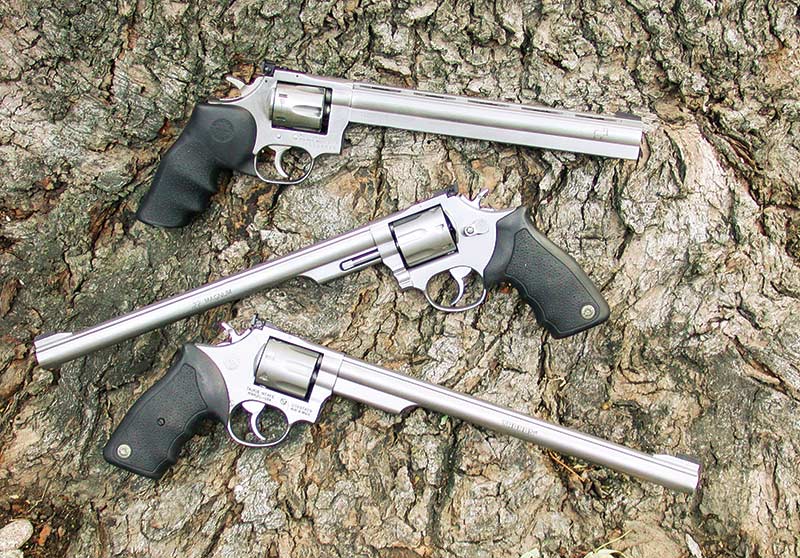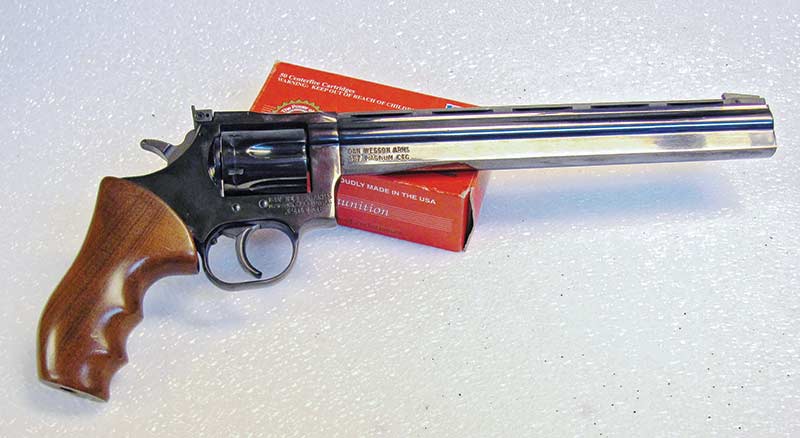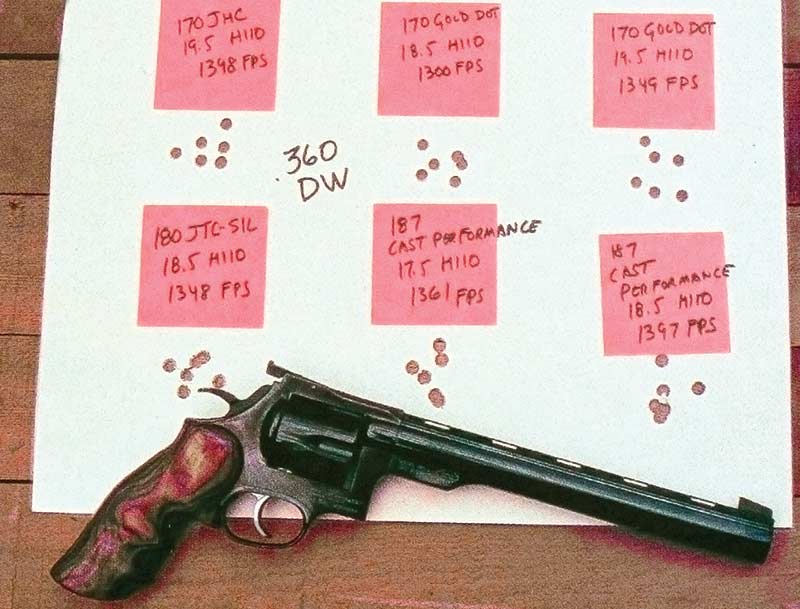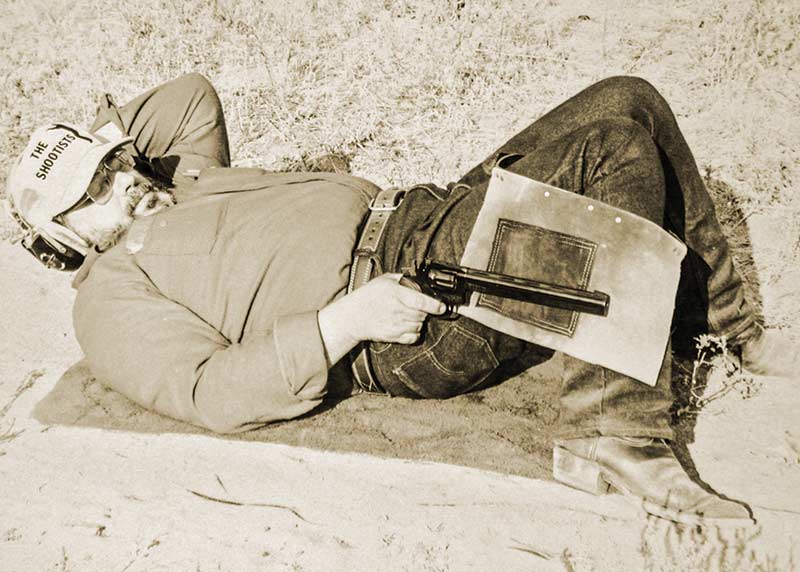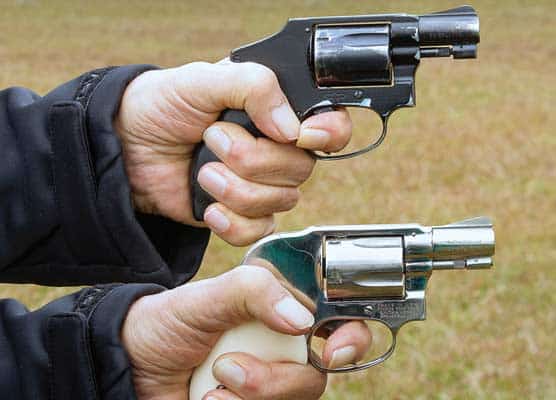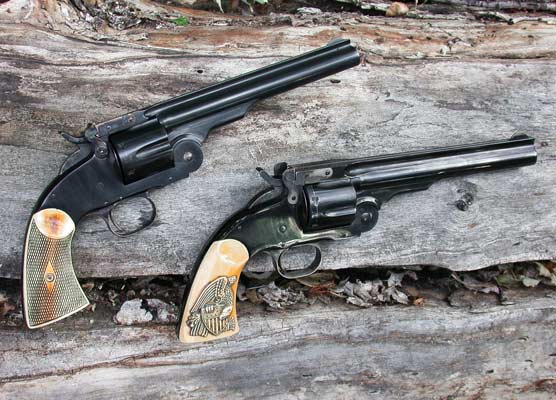Perfect 10: Dan Wesson
Double-Actions
Pingin’ Steel for real
It was 1975. Lee Jurras, who had earlier founded Super Vel and brought handgun ammunition into the 20th century, called handgunners together in Tucson to compete in what he called the National Handgun Metallic Silhouette Championship. One year later, the second handgun metallic silhouette championship was held in El Paso. During that tournament, 12 men came together and formed the International Handgun Metallic Silhouette Association (IHMSA). The targets were metal cutouts of chickens, pigs, turkeys and rams at distances of 50 to 200 yards or meters.
Give ’Em What They Want
The one company that really listened to silhouette shooters was Dan Wesson. The Dan Wesson .357 was the first revolver to offer interchangeable barrels, interchangeable grips and interchangeable front sights.
The Dan Wesson grip was a radical departure. Instead of two pieces of wood bolted to two sides of the grip frame, the Dan Wesson stocks were a one-piece style fitting over a stud instead of a grip frame. They bolted on from the bottom and Dan Wesson revolvers soon were the only sixguns coming from the factory with truly usable grips, not ill-shaped concoctions the hand had to adapt to.
The unique offering from Dan Wesson was an interchangeable barrel system. The original idea was to be able to offer multiple guns for the price of one. As an extra added bonus, the shooter received exceptional accuracy. The accuracy may have been designed into the gun but I’m more inclined to believe it was a fortunate byproduct.
They responded with longer barrels and better sights and during the early days dominated the IHMSA Revolver Class. They continued to improve the adjustable rear sight and also provided different styles of interchangeable front sights.
The number one revolver in the beginning was the Dan Wesson Heavy Barrel .357 Magnum, available in both 8″ and 10″ barrel lengths. I went with the latter and quickly settled on the use of the RCBS .35 Remington bullet. The Dan Wesson .357 Magnum is a medium-framed sixgun with a relatively small and short cylinder compared to the .44 Magnum version. I soon found using the 200-grain bullet necessitated the use of .38 Special cases to be able to crimp the bullet and not have it protrude through the front end of the cylinder.
Using .38 Special brass and this heavy bullet, along with the small cylinder, limited the powder capacity and thus the muzzle velocity. My loads were about 900 fps. Felt recoil was quite mild and with the copper-based bullets, a phenomenon occurred. On a bright sunny day, if the angle of the sun was right, the gas checks picked up the sunlight and this, combined with the relatively slow muzzle velocity, allowed one to see the bullets as they traveled toward the target. On ram targets it was possible to know ahead of time if the target would be hit just by seeing the path the bullet was following to the target.
A Request
In my files is a copy of the letter received from Dan Wesson himself in April 1977. I had written asking for a larger sixgun in .44 Magnum and .45 Colt and was told: “… the .44 Magnum is on the drawing board.” Dan Wesson had to go to the drawing board to come up with a large-framed sixgun as the .357 Magnum was much too small to handle the .44 Magnum. They absolutely did it right and when the .44 Magnum Dan Wesson arrived, it was a beautifully finished sixgun.
At the time, no one even came close to the bluing provided by Dan Wesson. Weighing in at over 4 lbs. with the 8″ heavy barrel, combined with usable factory stocks, the Dan Wesson .44 was the most pleasant shooting of all double-action .44 Magnums. It was excellent for hunting but one problem for silhouetters was the fact it was too heavy to make the required 4-lb. weight limit. With some judicious metal removal from the heavy shroud, the factory was able to get the new .44 Magnum to make weight and to also offer a 10″ standard-barreled model, my particular favorite, which also made it under the 4-lb. weight ceiling.
The .357 Dan Wesson revolvers soon became scarce on the firing line as they were replaced by the .44. Although the long-barreled .357 Magnum properly loaded with heavyweight bullets was entirely adequate, especially after the topple point rule went into effect making targets easier to fall, the switch was still made to the big .44 Magnum in droves.
The early .44 Magnums had ported barrels and shrouds, but these caused problems as crud from fired bullets worked its way in between the barrel and shroud, making barrel changing quite difficult. The ports were not needed anyway as the 4-lb. weight of the Dan Wesson .44 really tamed the .44 Magnum.
Rimfire Arrives
When IHMSA added a .22 class, Dan Wesson responded with a 10″ heavy barreled sixgun, which was unique in that although it looked like a double-action revolver, it was actually a single-action as the double-action fly had been removed. This made it not only a grand silhouette sixgun but also great for small game and varmints.
One of the last 10″ Dan Wesson revolvers was the Model 360. Built on the large frame, it utilized an extended .357 Magnum case known as the .360 DW, which allowed more performance with .357 bullets, without going to an extended frame and barrel.
One of the problems inherent with the Dan Wesson sixgun was the fact it never really caught on with either law-enforcement or civilians to a great extent, except those who participated in long-range silhouetting. This provided many sales for the Dan Wesson sixguns as metallic silhouette competition spread across the country and the world in the early 1980s. The popularity of the Dan Wesson revolver followed the interest in the competition. When silhouetting competition involvement started to decline, Dan Wesson followed the same path. And although they made fine, albeit heavy, hunting handguns, large numbers of handgun hunters never really took to the big-bore Dan Wesson. For the most part, the fortunes of the Dan Wesson revolver rose and fell with the curves of silhouetting. Coupled with this was the discovery by serious competitors of the Freedom Arms revolver. Everyone had to have a Dan Wesson revolver for competition in the 1980s. That crest soon passed and Dan Wesson paid the price.
